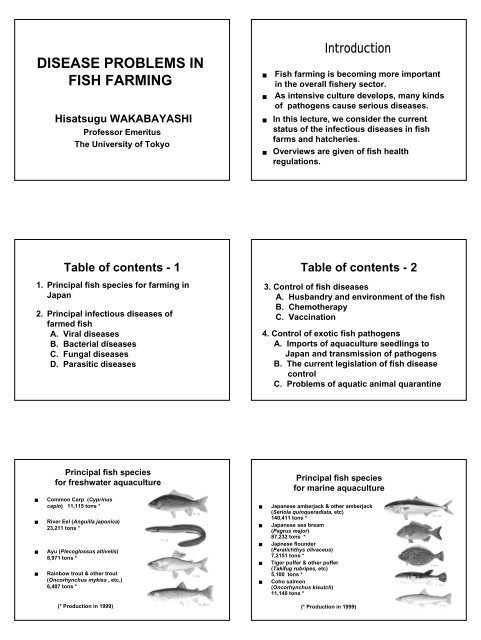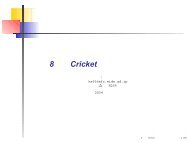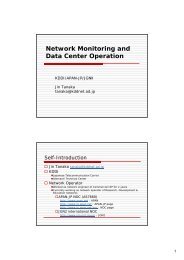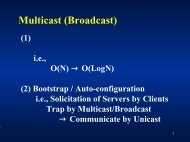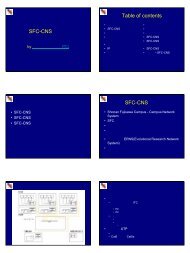DISEASE PROBLEMS IN FISH FARMING - SOI-Asia
DISEASE PROBLEMS IN FISH FARMING - SOI-Asia
DISEASE PROBLEMS IN FISH FARMING - SOI-Asia
You also want an ePaper? Increase the reach of your titles
YUMPU automatically turns print PDFs into web optimized ePapers that Google loves.
<strong>DISEASE</strong> <strong>PROBLEMS</strong> <strong>IN</strong><br />
<strong>FISH</strong> FARM<strong>IN</strong>G<br />
Hisatsugu WAKABAYASHI<br />
Professor Emeritus<br />
The University of Tokyo<br />
<br />
Fish farming is becoming more important<br />
in the overall fishery sector.<br />
As intensive culture develops, many kinds<br />
of pathogens cause serious diseases.<br />
In this lecture, we consider the current<br />
status of the infectious diseases in fish<br />
farms and hatcheries.<br />
Overviews are given of fish health<br />
regulations.<br />
Table of contents - 1<br />
1. Principal fish species for farming in<br />
Japan<br />
2. Principal infectious diseases of<br />
farmed fish<br />
A. Viral diseases<br />
B. Bacterial diseases<br />
C. Fungal diseases<br />
D. Parasitic diseases<br />
Table of contents - 2<br />
3. Control of fish diseases<br />
A. Husbandry and environment of the fish<br />
B. Chemotherapy<br />
C. Vaccination<br />
4. Control of exotic fish pathogens<br />
A. Imports of aquaculture seedlings to<br />
Japan and transmission of pathogens<br />
B. The current legislation of fish disease<br />
control<br />
C. Problems of aquatic animal quarantine<br />
<br />
<br />
<br />
<br />
Principal fish species<br />
for freshwater aquaculture<br />
Common Carp (Cyprinus<br />
capio) 11,115 tons *<br />
River Eel (Anguilla japonica)<br />
23,211 tons *<br />
Ayu (Plecoglossus altivelis)<br />
8,971 tons *<br />
Rainbow trout & other trout<br />
(Oncorhynchus mykiss , etc.)<br />
6,407 tons *<br />
(* Production in 1999)<br />
<br />
<br />
<br />
<br />
<br />
Principal fish species<br />
for marine aquaculture<br />
Japanese amberjack & other amberjack<br />
(Seriola quinqueradiata, etc)<br />
140,411 tons *<br />
Japanese sea bream<br />
(Pagrus major)<br />
87,232 tons *<br />
Japnese flounder<br />
(Paralichthys olivaceus)<br />
7,2151 tons *<br />
Tiger puffer & other puffer<br />
(Takifug rubripes, etc)<br />
5,100 tons *<br />
Coho salmon<br />
(Oncorhynchus kisutch)<br />
11,148 tons *<br />
(* Production in 1999)
Estimated annual losses<br />
in income due to diseases<br />
Table of contents - 1<br />
1. Principal fish species for farming in<br />
Japan<br />
2. Principal diseases of farmed fish<br />
A. Viral diseases<br />
B. Bacterial diseases<br />
C. Fungal diseases<br />
D. Parasitic diseases<br />
Virus family<br />
Birnavirus<br />
Rhabdovirus<br />
Nodavirus<br />
Retrovirus ()<br />
Togavirus ()<br />
2-A. Principal viral pathogens of fish -1<br />
RNA virus<br />
* No reports in Japan<br />
Disease<br />
infectious pancreatic necrosis<br />
yellowtail ascites<br />
infectious hematopoietic necrosis<br />
Hirame rhabdoviral disease<br />
viral hemorrhagic septicemia *<br />
spring viremia of carp *<br />
viral nervous necrosis<br />
viral whirling disease<br />
erythrocytic inclusion body synd.<br />
Pathogen<br />
IPNV<br />
MBV<br />
IHNV<br />
HIRRV<br />
VHS<br />
SVC<br />
VNNV<br />
VWD<br />
EIBSV<br />
salmonids<br />
amberjack<br />
flounder<br />
salmonids<br />
cyprinids<br />
Host<br />
salmonids<br />
most marine fishes<br />
coho salmon<br />
coho salmon<br />
Virus family<br />
Iridovirus<br />
Herpesvirus<br />
Adenovirus()<br />
Unknown<br />
2-A. Principal viral pathogens of fish - 2<br />
DNA virus<br />
* No reports in Japan<br />
Disease<br />
lymphocystis disease<br />
viral erythrocytic necrosis<br />
red sea bream iridoviral disease<br />
epizootic hematopoietic necrosis *<br />
Oncorhynchus masou virus disease<br />
= Salmonid herpesvirus type 2 dis.<br />
viral epidermal hyperplasia<br />
viral papilloma of carp<br />
channel catfish virus disease *<br />
viral endothelial cell necrosis of eel<br />
kuchijirosho (snout ulcer disease)<br />
Pathogen<br />
LCDV-2<br />
VENV<br />
RSIV<br />
EHNV<br />
OMV<br />
SaHV-2<br />
VEHV<br />
CyHV-1<br />
CCHV<br />
most marine fishes<br />
salmonids<br />
parch<br />
salmonids<br />
flounder<br />
carp<br />
catfish<br />
Host<br />
most marine fishes<br />
Japanese eel<br />
tiger puffer<br />
Infectious pancreatic necrosis (IPN) - 1<br />
IPN is a viral disease principally associated with salmonids.<br />
IPNV and IPN-like virus have been isolated from many kinds of<br />
freshwater and marine fishes, crustaceans, and molluscs.<br />
IPN occurs in North America, Europe, <strong>Asia</strong> (Japan, Korea, China,<br />
Taiwan,and Thailand), South Africa, New Zealand, and Chile.<br />
In salmonids, acute infection occur in one- to four month-old-fish.<br />
Fish swim rotating about the long axis or whirling violently.<br />
Clinical signs include dark pigmentation, exophthalmia, abdominal<br />
distension, mucoid fecal casts, and hemorrhages on the body (A).<br />
Marked pathological changes occur in the pancreatic tissues (B).<br />
Infectious pancreatic necrosis (IPN) - 2<br />
IPNV is the first fish virus to be grown in vitro.<br />
Wolf and Quimby (1962) developed methods for culturing the<br />
fish cells, initiated the RTG-2 cell line (A), and noted its<br />
susceptibility to IPNV (B).<br />
In RTG-2 cells, CPE becomes apparent within 48 hours at 20.<br />
The identifying features of the IPNV plaques are a reticulum of<br />
elongated, shrunken dead cells, and coarsely stellate margins<br />
from which living cells radiate inward (Wolf and Quimby, 1973)<br />
A<br />
B<br />
A<br />
B
Infectious pancreatic necrosis (IPN) - 3<br />
Infectious pancreatic necrosis (IPN) - 4<br />
Negatively stained IPN virion shows a typical hexagonal profile. (A)<br />
The diameter is variously given as 55 to 75 nm.<br />
IPNV is a nonenveloped icosahedron with a single capsid containing 92<br />
capsomeres.<br />
IPNV has two species of RNA, and it has an RNA-dependent polymerase<br />
that catalyzes synthesis of single-stranded RNA from the double-<br />
IPNV belongs to the family Birnaviridae. (B)<br />
<br />
Fig. Characteristic patterns of morphological changes in RTG-2 cells due to CPE of<br />
representative fish viruses., IPNV, IHNV, and salmonid herpesvirus. Reprinted<br />
from Sano (2000): A Technical Manual of Fish Virus Examination. Fisheries and<br />
Aquacultuere International Co. Ltd., Tokyo, p. 42.<br />
1) Normal, 2) IPNV, 3) IHNV, 4) Salmonid herpesvirus<br />
A<br />
<br />
B<br />
<br />
<br />
<br />
<br />
<br />
<br />
<br />
<br />
Spring viremia of carp (SVC)<br />
The name of SVC was used to<br />
distinguish the viral infection from the<br />
IDC complex (Fijan et al. , 1971).<br />
IDC had been known in pond-cultured<br />
carp in Europe since early 20th cent.<br />
SVC occurs in Europe and China. (not<br />
in Japan)<br />
Diseased fish have a distended<br />
abdomen and show exophthalmia and<br />
petechiation of skin. (fig. A)<br />
Petechiation is evident in the heart,<br />
liver, kidney, intestine, peritoneum,<br />
swim bladder, and skeletal muscle. (B)<br />
Rhavdovirus carpio, or SVCV, is<br />
typically bullet shaped, 60 to 90 nm<br />
wide and 90 to 180 nm long. (fig. C)<br />
The CPE begins as focal areas of cell<br />
rounding and sheet contraction. (fig. D)<br />
A<br />
B<br />
C<br />
D<br />
<br />
<br />
<br />
Viral epidermal hyperplasia (VEH)<br />
VEH causes mortalities in hatcheryreared<br />
larvae of Japanese flounder (Iida<br />
et al., 1989; Miyazaki et al., 1989). (Fig.A)<br />
The affected fish showed epidermal<br />
hyperplasia on the fins (fig. B) and skin<br />
with vacuolar degeneration of the<br />
Marpighian cells, and necrosis in advanced<br />
stages of the infection (Iida et al., 1991).<br />
Although the causative virus ( flounder<br />
herpesvirus (FHV) ) has not been isolated in<br />
cultured cells, FAT using a rabbit antiserum<br />
against purified virus (fig. C) has been used<br />
for diagnosis (Nakai et al., 1991).<br />
A<br />
B<br />
C<br />
D<br />
2-B. Principal bacterial pathogens of fish<br />
Gram-negative bacteria - 1<br />
Pathogen<br />
Flavobacterium group<br />
Flavobacterium columnare<br />
Flavobacterium psychrophilum<br />
Flavobacterium branchiophilum<br />
Tenacibaculam matitimum<br />
Pseudomonadaceae<br />
Pseudomonas anguilliseptica<br />
Pseudomonas plecoglossicida<br />
Aeromonadaceae<br />
Aeromonas hydrophila<br />
Aeromonas salmonicida<br />
marine gliding bacterial d.<br />
red spot disease (Sekiten-byo)<br />
bacterial hemorhagic ascites<br />
motile aeromonad septicemia<br />
furunculosis<br />
Disease<br />
columnaris disease<br />
bacterial coldwater disease<br />
bacterial gill disease<br />
most freshwater f.<br />
salmonids, etc.<br />
salmonids & ayu<br />
most marine fishes<br />
eel & marine fishes<br />
ayu<br />
Host<br />
most freshwater f.<br />
salmonids, etc.<br />
2-B. Principal bacterial pathogens of fish<br />
Gram-negative bacteria - 2<br />
Vibrio ordali<br />
Pathogen<br />
Vibrionaceae<br />
Vibrio anguillarum<br />
Vibrio ichthyoenteri<br />
Photobacterium damselae<br />
subsp. pisicida<br />
Enterobacteiaceae<br />
Edwardsiella tarda<br />
Edwardsiella ictaluri *<br />
Yersinia ruckeri *<br />
Rickettia<br />
Piscirickettsia salmonis *<br />
vibriosis<br />
vibriosis<br />
Disease<br />
Intestinal necrosis<br />
edwardsiellosis<br />
enteric septicemia of catfish<br />
enteric redmouth<br />
salmonid rickettial septicemia<br />
most marine fishes<br />
most marine fishes<br />
Japanese flounder<br />
various marine fishes<br />
freshwater & marine f.<br />
channel catfish, etc.<br />
salmonids<br />
salmonids<br />
Host
2-B. Principal bacterial pathogens of fish<br />
Gram-positive bacteria<br />
Pathogen<br />
‘Lactic acid’ bacteria<br />
Lactococcus garvieae<br />
Streptoccus iniae<br />
Acid-fast bacteria<br />
Mycobacterium marium<br />
Nocardia seriolae<br />
Miscellaneus bacteria<br />
Renibacterium salmoninarum<br />
streptococcosis<br />
streptococcosis<br />
mycobacteriosis<br />
nocardiosis<br />
Disease<br />
bacterial kidney disease<br />
various marine fishes<br />
various freshwater f.<br />
various marine fishes<br />
amberjack, etc.<br />
salmonids<br />
Host<br />
<br />
<br />
<br />
<br />
<br />
<br />
Columnaris disease - 1<br />
Distribution of columnaris disease is<br />
probably worldwide.<br />
All freshwater fishes are probably<br />
susceptible to columnaris under<br />
environmental conditions favorable to<br />
the pathogen and stressful to the fish.<br />
Outbreaks occur when water temp.<br />
reach 15and above.<br />
The pathogen primarily attacks the<br />
external tissues of the fish.<br />
Lesions are covered with a yellowish<br />
white mucoid exudate consisting of<br />
swarms of bacteria (figs. A&B).<br />
In the early stages of the infection,<br />
the bacteria grow on the tips of gill<br />
lamelae (fig. C), skins, and/or fins.<br />
A<br />
B<br />
C<br />
<br />
<br />
<br />
<br />
<br />
Columnaris disease - 2<br />
When pieces of infected tissues were<br />
examined microscopically in wet mount<br />
preparations, column-like masses of<br />
bacteria were observed along the margin<br />
of the tissues (fig. A). The bacteria show<br />
an active flexing movement and also<br />
display a slow gliding movement.<br />
Currently, the causative bacterium is<br />
renamed Flavobacterium columnare<br />
(Bernardet et al., 1996).<br />
The cells are Gram-negative, slender and<br />
long bacilli, 0.3-0.5m 3-8m (fig. B).<br />
Cytophaga agar (CA) (Anacker & Ordal,<br />
1989) is the most frequently used<br />
medium for cultivation of F. columnare.<br />
On CA, it produces pale yellow colonies<br />
which are of a spreading nature with<br />
irregular margins (fig. C).<br />
A<br />
B<br />
C<br />
<br />
<br />
<br />
<br />
<br />
Vibriosis (V. anguillarum infection)<br />
Vibrio anguillarum infection occurs throughout the world.<br />
The disease has been reported from fishes in brackish and marine<br />
waters and from several freshwater fishes.<br />
Disease signs are variable, but affected fish commonly have<br />
numerous raised, hemorrhagic, inflamed areas on the skin (fig. A).<br />
The cells of V. anguillarum are Gram-negative straight or curved<br />
rods 0.3-0.5m1.4-2.6m. They move by polar flagella (fig. B).<br />
They grow well in general purpose media with 1-2% NaCl (fig.C)<br />
A B C<br />
<br />
<br />
<br />
<br />
Streptococcosis (Lactococcus garviae infecton)<br />
Streptococcosis (L. garviae infection in particular) has been<br />
associated with serious economic loss in cultured Japanese<br />
amberjack since 1974 (Kusuda, 1976; Kitao et al., 1979).<br />
Clinical signs include exophthalmia and distended abdomen,<br />
hemorrhaging in the eye (fig. A), in the opercula and at the base of<br />
the fins, and necrotic ulcer formation on the caudal peduncle (fig. B).<br />
The causative agent is a Gram-positive spherical or oval bacteria<br />
less than 2 m in diameter, which occur in pairs or chain (fig. C).<br />
The organisms are well grow on TSA , BHIA, THBA, or blood agar.<br />
The colonies are small (0.5-1.0 mm diameter), yellowish, translucent,<br />
rounded and slightly raised (fig. D).<br />
A<br />
B<br />
C<br />
D<br />
2-C. Principal fungal pathogens of fish<br />
Pathogen<br />
Chitridiomycetes<br />
Dermocystidium koi<br />
Oomycetes<br />
Saprolegnia parasitica<br />
Saprolegnia diclina<br />
Aphanomyces piscicida<br />
Aphanomyces invadans*<br />
Entomophthorales<br />
Ichthyophonus hoferi<br />
Hyphomycetes<br />
Ochroconis humicola<br />
saprolegniasis<br />
saprolegniasis, visceral<br />
mycosis<br />
mycotic granulomatosis<br />
epizootic ulcerative syndrome<br />
ichthyophonosis<br />
ochroconiosis<br />
Disease<br />
dermocystidiosis<br />
carp<br />
salmonids, etc.<br />
salmonids, etc.<br />
ayu<br />
cyprinids<br />
Host<br />
trout, ayu, amberjack, etc.<br />
marine fish fry
Saprolegniasis<br />
Saprolegniasis is caused by the<br />
attachment of the zoospores (fig.<br />
C) of common water molds to<br />
the gills, skin, or fins (fig. A).<br />
The most prevalent species<br />
associated with infections are<br />
Saprolegnia parasitica (syn. S.<br />
diclina type 1) and S. ferax.<br />
Saprolegnia spp. are parasitic to<br />
fish and fish eggs of both warmwater<br />
and coldwater species.<br />
Fig. B: Saprolegnia sp. cultured<br />
on hemp seeds.<br />
Fig. C: Zoosporangium<br />
Fig. D: Oogonium and oosphere<br />
Fig. E: Gemma (chlamydospore)<br />
A<br />
B<br />
D<br />
C<br />
E<br />
2-D. Principal parasites of fish - 1<br />
Pathogen<br />
Disease<br />
Host (organ)<br />
Mastigophora<br />
Amyloodinium ocellatum amyloodiniosis<br />
marine fishes (gills)<br />
Ichthyobodo necator ichthyobodosis<br />
freshwater f. (gills & skin)<br />
Ichhyobodo sp.<br />
ichthyobodosis<br />
marine fishes (gills & skin)<br />
Microspora<br />
Glugea plecoglossi<br />
glugeosis<br />
ayu (viscera)<br />
Heterosporis anguillarum beko disease<br />
Japanese eel (muscle)<br />
Microsposidium seriolae beko disease<br />
Japan. Amberjack (muscle)<br />
Myxozoa<br />
Hoferellus carassi<br />
kidney enlargement d. goldfish (kidney)<br />
Kudo amamiensis<br />
kudoosis amami<br />
Japan. amberjack (muscle)<br />
Myxobolus koi<br />
gill myxobolosis<br />
carp (gills)<br />
Myxobolus buri<br />
myxosporean scoliosis Japan. amberjack (brain)<br />
2-D. Principal parasites of fish - 2<br />
Pathogen<br />
Disease<br />
Host (organ)<br />
Ciliophora<br />
Crtoticaryon irritans<br />
white spot disease marine fishes (skin)<br />
Ichthyophthirius multifiliis white spot disease freshwater fishes (skin)<br />
Scuticociliatida gen. sp. scuticociliatidosis flounder, etc. (skin, brain)<br />
Monogenea<br />
Benedenia seriolae<br />
skin fluke disease Japanese amberjack (skin)<br />
Neobenedenia girellae<br />
skin fluke disease Japan. flounder, etc.(skin)<br />
Heteraxine heterocerca gill fluke disease Japan. amberjack (gills)<br />
Heterobothrium okamotoi heterobothriosis tiger puffer (gills)<br />
Trematoda<br />
Diplostomum (metacercaria) worm cataract<br />
rainbow t., etc. (eye)<br />
Galactosomum (metacercaria) trematode whirling d. amberjack, etc. (brain)<br />
2-D. Principal parasites of fish - 3<br />
Pathogen<br />
Disease<br />
Host (organ)<br />
Nematoda<br />
Anisakis simplex<br />
(harmless to fish) marine fishes (viscera)<br />
Philometra lateolabracis<br />
gonad nematodosis sea bream (gonad)<br />
Anguillicola crassus<br />
anguillicolosis Jpn. /Eur. eel (swim bladder)<br />
Acanthocephala<br />
Acanthocephalus opsariichthydis acanthocephalosis rainbow t. etc. (intestines)<br />
Longicollum pagrosomi<br />
longicollosis sea bream (intestines)<br />
Crastacea<br />
Argulus japonicus<br />
argulosis<br />
cyprinids (skin)<br />
Lernea cyprinacea<br />
anchor worm d. cyprinids (skin), eel (mouth)<br />
Caligus spinosus<br />
gill caligosis greater amberjack (blood)<br />
Paradeontacylix grandispinus<br />
blood fluke disease<br />
greater amberjack (blood)<br />
Table of contents - 2<br />
3. Control of fish diseases<br />
A. Husbandry and environment of the fish<br />
B. Chemotherapy<br />
C. Vaccination<br />
4. Control of exotic fish pathogens<br />
A. Imports of aquaculture seedlings to<br />
Japan and transmission of pathogens<br />
B. The current legislation of fish disease<br />
control<br />
C. Problems of aquatic animal quarantine<br />
<br />
<br />
<br />
3. Control of fish diseases<br />
The relationship between a pathogen, host,<br />
and the environment<br />
Serious losses only occur when a pathogen and a host are<br />
present in an environment which favors the disease.<br />
When the pathogen and host are present but the environment<br />
is not favorable for the disease, no outbreak occurs.<br />
Also, when the environment is favorable for disease and the<br />
host is present, no outbreak occurs unless the pathogen is<br />
also present.<br />
Many diseases are difficult to treat, some are impossible.<br />
Such diseases can only be controlled by the provision of<br />
improved environmental and nutritional conditions.<br />
Losses from some disease situations can be stopped or<br />
reduced by drug or chemical therapy and/or vaccination.
3-A. Husbandry and environment of the fish<br />
Portal of entry into fish for pathogens<br />
Superficial abrasion<br />
of fish body, while<br />
not immediately<br />
critical, affords a<br />
portal of entry for<br />
infectious agents.<br />
<br />
The transport,<br />
transfer, and<br />
handling of fish<br />
should be done by<br />
the least damaging<br />
method.<br />
Abrasion<br />
Fig. The outside and inside of fish<br />
3-A. Husbandry and environment of the fish<br />
Adherence of bacterial cells<br />
to the fish body surface<br />
A) Green fluorescent proteinlabeled<br />
Pseudomonas<br />
plecoglossicida cells (A-1) and<br />
blue fluorescent microspheres<br />
(A-2) in the fin of ayu which has<br />
been immersed in a mixture of<br />
them for 15 min.<br />
B) After bathing the microsphere<br />
suspension, the fish was<br />
dipped into a 0.05% trypan blue<br />
solution for 10 min.<br />
B-1: Microscopic injuries in the<br />
fin are stained with trypan blue.<br />
B-2: Fluorescent microspheres<br />
(green) are located in the<br />
micro-injuries.<br />
A-1<br />
A-2<br />
B-1 B-2<br />
3-A. Husbandry and environment of the fish<br />
The effects of stress on fishes - 1<br />
Social subordination<br />
paradigm:<br />
Encounter between<br />
dominant and<br />
subordinate fish, the<br />
resulting physiological<br />
changes, and how these<br />
modulate the immune<br />
system.<br />
(Cooper, E.L., Faisal,<br />
M.J.: Experimental<br />
Zoology Supplement 4:<br />
46-52, 1990)<br />
<br />
Badly out-of- size fish<br />
are usually more prone<br />
to disease outbreak.<br />
3-A. Husbandry and environment of the fish<br />
The effects of stress on fishes - 2<br />
Morphological changes<br />
in the stomach of the<br />
European eel under<br />
social stress:<br />
The stomach of<br />
subordinate eel<br />
shrinks, and the<br />
diameter and length of<br />
the gastric caecum<br />
decrease (fig. c & d).<br />
The originally firm,<br />
deep mucous<br />
membrane folds (fig. a)<br />
become flattened in<br />
subordinate eel (fig. c).<br />
(Peters, G: J. Fish Biol. , 21,<br />
497-512, 1982)<br />
3-A. Husbandry and environment of the fish<br />
The effects of Stress on fishes - 3<br />
Defense activities of<br />
neutrophils of tilapia were<br />
investigated under the social<br />
stress.<br />
A large fish (about 143 g) and<br />
a small fish ( about 91 g) were<br />
in an aquarium. As control a<br />
large and a small were held<br />
individually.<br />
Within a few hours postpairing,<br />
the large become<br />
dominat in all pairs tested.<br />
The phagocytic ability (fig. A)<br />
and respiratory burst activity<br />
(fig. B) of subordinate fish<br />
were both reduced.<br />
(Kuroki, J. & Iida, T: Fish<br />
Pathology, 34, 15-18, 1999)<br />
<br />
<br />
<br />
<br />
B. Chemotherapy - 1<br />
Unlike human or cattle, which are treated on an individual basis<br />
under carefully controlled conditions, farm fish must be treated<br />
en masse and under the law of averages.<br />
A suitable chemotherapeutic agent must be:<br />
1) Effective against the pathogen;<br />
2) Of low toxicity, palatable, promptly and fully eliminated by the<br />
fish;<br />
3) Permitted by national and international regulations.<br />
The daily amounts of the drug must be regulated on the amount<br />
of food which is eaten by diseased fish, often a difficult<br />
assignment.<br />
Fish farmer must be required to know:<br />
1) Weight and nature of drugs to be included in the food;<br />
2) Amount of food to feed, in percent of fish body weight, per<br />
day;<br />
3) Period of treatment, in days or in weeks;<br />
4) Interval of time required following cessation of therapy before<br />
fish marketing.
B. Chemotherapy - 2<br />
A list of drugs registered for fishery use in Japan (2000)<br />
B. Chemotherapy - 3<br />
Regulation on the Use of Drugs in Japan<br />
The regulation are in place regarding the<br />
standardized use of registered drugs.<br />
Fish farmers purchase drugs following<br />
the advice of the prefecture fish disease<br />
control center from veterinary drug<br />
stores.<br />
Prescriptions for the drugs are not<br />
necessarily required.<br />
Fish farmers must stick by the<br />
standardized use of the drug.<br />
<br />
B. Chemotherapy - 4<br />
Problems on the Use of Drugs<br />
The extensive uses of drugs have increased the<br />
incidence of drug resistance in fish-pathogenic and<br />
environmental bacteria.<br />
It gets more difficult to find effective drugs for fish<br />
diseases.<br />
Recently, particular attention was paid to the<br />
problem of drug residues in treated fish.<br />
Long interval time (2 ~4 weeks) is required<br />
following cessation of therapy before fish marketing.<br />
(Because fish is cold-blooded animal, the interval<br />
time for fish is much longer than that for cattle and<br />
poultry (1 or 2 days).<br />
C. Vaccination<br />
A list of vaccine registered for fishery use in Japan (2000)<br />
Disease<br />
controlled<br />
Vibriosis<br />
Vibriosis<br />
Streptococcosis<br />
Iridovirus<br />
infection<br />
Streptococcosis<br />
and vibriosis<br />
Pathogen<br />
Vibrio anguillarum<br />
J-O-1<br />
Vibrio anguillarum<br />
J-O-1 and J-O-3<br />
Lactococcus garvieae<br />
RSIV (Iridovirus)<br />
Lactococcus garvieae<br />
and Vibrio<br />
anguillarum J-O-3<br />
Type of<br />
vaccine<br />
formalized<br />
formalized<br />
formalized<br />
formalized<br />
formalized<br />
Fish applied<br />
ayu<br />
salmonid fish<br />
Japanese<br />
amberjack<br />
red sea bream<br />
& amberjack<br />
Japanese<br />
amberjack<br />
Method of<br />
application<br />
immersion<br />
immersion<br />
Oral<br />
(on food)<br />
injection<br />
i.p.<br />
injection<br />
i.p.<br />
For further information, listen to Dr. Nakanishi’s lecture, please.<br />
Table of contents - 2<br />
3. Control of fish diseases<br />
A. Husbandry and environment of the fish<br />
B. Chemotherapy<br />
C. Vaccination<br />
4. Control of exotic fish pathogens<br />
A. Imports of aquaculture seedlings to<br />
Japan and transmission of pathogens<br />
B. The current legislation of fish disease<br />
control<br />
C. Problems of aquatic animal quarantine<br />
4-A. Imports of aquaculture seedlings to<br />
Japan and transmission of pathogens<br />
Transmission of Pathogens in Salmonid Fish - 1<br />
Disease<br />
- Pathogen<br />
Infectious hematopoietic necrosis<br />
(IHN)<br />
Bacterial kidney disease (BKD)<br />
Š Renibacterium salmoninarum<br />
Bacterial cold-water disease<br />
(BCWD)<br />
Š Flavobacterium psychrophilum<br />
Introduction year<br />
Speculated/Confirmed<br />
Suspected carrier<br />
1971 / 1971 Sockeye salmon eggs<br />
from Alaska<br />
1973 / 1973 Coho salmon eggs<br />
from the Pacific coast<br />
1985 / 1990 Coho salmon eggs<br />
from the Pacific coast
Transmission of Pathogen in Salmonids Fish - 2<br />
BCWD of coho salmon fry caused by<br />
Flavobacterium psychrophilum<br />
Transmission of Pathogen in Salmonid Fish - 2.<br />
Detection of Flavobacterium psychrophilum from<br />
coho salmon eggs and fry<br />
The clinical sings of BCWD<br />
has been recognized since<br />
1985 in coho salmon and ayu.<br />
A large number of coho<br />
salmon eggs has been<br />
imported annually from the<br />
North America for culture<br />
purpose since 1975.<br />
The samples of imported eggs<br />
were often positive for F.<br />
psychrophilum by inspection.<br />
Transmission of Pathogens in Marine Fishes - 1<br />
Source and transportation of imported seedlings<br />
for marine fish and shellfish culture<br />
Transmission of Pathogens in Marine Fishes -2<br />
Pathogens and parasites suspected to have been introduced<br />
into Japan in association with importations<br />
of marine fish seedlings from <strong>Asia</strong>n countries<br />
Disease<br />
-Pathogen or parasite<br />
Introduction year<br />
Speculated/Confirmed<br />
Suspected carrier<br />
Epitheliocystis 1978 / 1978 Japanese sea-bream<br />
seedlings from Hong-<br />
Kong<br />
Neobenedenia girellae 1991 / 1991 Greater amberjack<br />
seedlings from Hainan<br />
Penaeid acute<br />
viremia<br />
syn.white spot<br />
syndrome<br />
1993 / 1993 Penaeus.japonicus<br />
seedlings<br />
from Fujiang<br />
4-B. The current legislation of fish disease<br />
control -1<br />
International Aquatic Animal Health Code - 2003<br />
Office International des Epizooties (O.I.E)<br />
Part 1. General Provisions<br />
Section 1.1. General definitions<br />
Section 1.2. Notification systems<br />
Section 1.3. Obligations and ethics in international trade<br />
Section 1.4. Import risk analysis<br />
Section 1.5. Import/export procedure<br />
Section 1.6. Guidelines for contingency planning<br />
Section 1.7. Fallowing<br />
Part 2. Diseases of Fish<br />
Part 3. Diseases of Molluscs<br />
Part 4. Diseases of Crustacceans<br />
Part 5. Appendices<br />
Part 6. Model International Aquatic Animal Health Certificate<br />
4-B. The current legislation of fish disease<br />
control - 2<br />
The Fishery Resources Conservation Law<br />
(Japan) - 1<br />
The Law was amended in 1996.<br />
The person who intends to import seeds of aquatic<br />
animals for propagation or aquaculture purposes<br />
shall obtain license issued by the Minister of<br />
Agriculture, Forestry and Fisheries (MAFF).<br />
The application must be accompanied with<br />
certificates issued by the government authorities<br />
of exporting country.
The Fishery Resources Conservation Law<br />
(Japan) - 2<br />
Infectious diseases of aquatic animal seeds<br />
prescribed pursuant to the Law<br />
Aquatic animal seeds<br />
Carp fry<br />
Eyed eggs and fry<br />
of Salmonidae<br />
Larvae, postlarvae and<br />
juvenile of Penaeus<br />
Infectious diseases<br />
Spring viremia of carp (SVC)<br />
Viral hemorrhagic septicemia (VHS)<br />
Epizootic hematopoietic necrosis (EHN)<br />
Piscirickettsiosis<br />
Enteric redmouth disease (ERM)<br />
Nuclear polyhedrosis vaculoviroses<br />
Infectious hypodermal & hematopoietic<br />
necrosis<br />
Yellowhead disease<br />
Penaeid acute viremia / White spot syndrome<br />
4-B. The current legislation of fish disease<br />
control - 3<br />
The Law to Ensure Sustainable Aquaculture<br />
Production (Japan) -1<br />
Prevention of diffusion of specific diseases:<br />
The Governor can issue orders as stipulated in the<br />
following items.<br />
- To limit or prohibit owners of the animals which<br />
have, or suspected to have, a specific disease to<br />
transfer them.<br />
- To order the owners to burn or bury them.<br />
- To order owners of the fishing nets, cage and other<br />
equipment to which pathogens of some specific<br />
disease are attached, or suspected, to disinfect it.<br />
The Law to Ensure Sustainable Aquaculture<br />
Production (Japan) - 2<br />
On-the-site inspection: The Governor can have<br />
his officials enter the aquaculture ground to<br />
inspect aquatic animals and plants.<br />
Fish disease prevention official (FDPO) and fish<br />
disease prevention cooperative staff (FDPCS):<br />
The governor shall assign FDPO from his staff,<br />
and can entrust FDPCS from those who have<br />
expertise on diseases of aquatic organisms.<br />
<br />
<br />
<br />
<br />
<br />
4-C. Problems of aquatic animal quarantine - 1<br />
The large number of farms precludes regular<br />
inspection of each farm.<br />
Too many kinds of fish are cultured (approximately<br />
thirty different marine- and ten freshwater fishes).<br />
Most of the imported mariculture seedlings are<br />
transported by ship; the aquarium are supplied with<br />
seawater from ocean, and the effluent flows back.<br />
Most of the marine fish species has not yet been<br />
farmed in the exporting countries.<br />
Apart from aquaculture seedlings, a large number of<br />
various ornamental fishes are imported.<br />
Tentative plans to improve health standards<br />
for imported aquaculture seedlings<br />
Thank you for your attention<br />
More precise records on the importation of seedlings<br />
from all traders and farmers.<br />
Exchange of information between the exporting<br />
countries and Japan on pathogens and parasites.<br />
Cooperative research with the exporting countries on<br />
disease of mariculture seedlings.<br />
Dissemination of epizootiological knowledge to<br />
traders and farmers.<br />
Creation of a network system providing information<br />
on epizootics in aquaculture,<br />
Development and standardization of diagnostic<br />
techniques.


